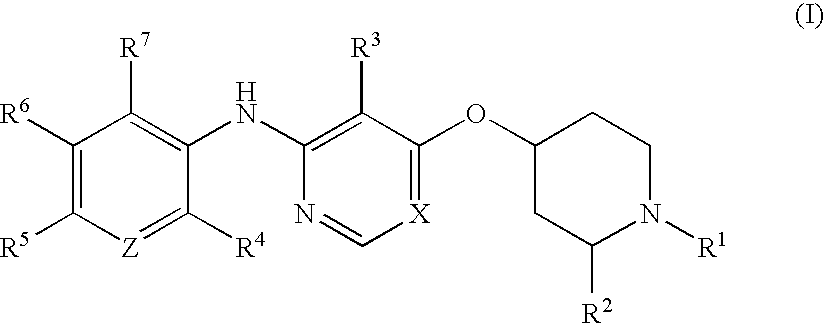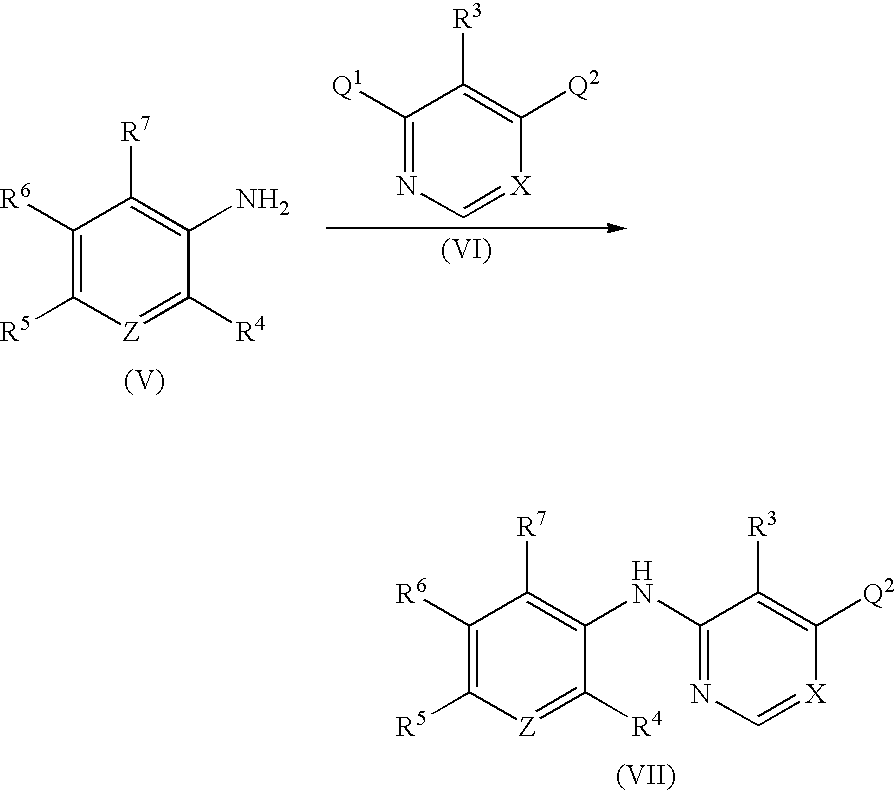Process for the preparation of tri-substituted pyridine and tri-substituted pyrimidine derivatives useful as gdir agonists
a technology of tri-substituted pyridine and tri-substituted pyrimidine, which is applied in the field of new products, can solve the problems of elevated blood glucose levels, serious health problems, and inability to move glucose into the cells of patients,
- Summary
- Abstract
- Description
- Claims
- Application Information
AI Technical Summary
Benefits of technology
Problems solved by technology
Method used
Image
Examples
example 1
(6-Chloro-5-methoxy-pyrimidin-4-yl)-(6-methanesulfonyl-2-methyl-pyridin-3-yl)-amine
[0291]
[0292]A 100-mL Schlenk flask with a magnetic stir bar was charged with 4,6-dichloro-5-methoxypyrimidine (4.66 g, 0.026 mol), 6-methanesulfonyl-2-methyl-3-pyridinamine (3.72 g, 0.020 mol), and DMSO (20 mL). After the mixture was stirred to dissolve the components, Cs2CO3 (8.48 g, 0.026 mol) was added, and the resulting mixture heated to 60° C. After 4.5 h and additional portion of Cs2CO3 (2.00 g, 0.0061 mol) was added and heating continued overnight. The reaction was quenched by addition of the reaction mixture to well stirred, saturated NH4Cl (200 mL); resulting in the formation of a tan precipitate. The precipitate was filtered, air dried and stirred with MTBE, and the resulting mixture filtered again. The resulting solid was purified by column chromatography on silica gel (200 g) using CH2Cl2 followed by 1% IPA-CH2Cl2 after 2-L of CH2Cl2 had eluted to yield the title compound as a white to lig...
example 2
4-[6-(6-Methanesulfonyl-2-methyl-pyridin-3-ylamino)-5-methoxy-pyrimidin-4-yloxy]-piperidine-1-carboxylic acid isopropyl ester
[0296]
[0297]A 100 mL Schlenk flask with a magnetic stir bar, septum, heating mantle, and thermocouple was charged with (6-chloro-5-methoxy-pyrimidin-4-yl)-(6-methanesulfonyl-2-methyl-pyridin-3-yl)-amine (658.1 mg, 2 mmol), blocked 4-hydroxypiperidine (3.753 g, 20 mmol), 1,4-dioxane (20 mL) followed by KO-t-Bu (455 mg, 4 mmol). On addition of KO-t-Bu a pronounced exotherm was observed. After the exotherm had subsided, the he resulting mixture was heated to 85° C. and followed by HPLC. When the reaction progress began to slow, an additional charge of KO-t-Bu (230 mg, 2.05 mmol) was added (Note 2). When the reaction progress began to slow again, a third charge of KO t-Bu (110 mg, 1 mmol) was added. The reaction mixture was quenched by pouring the reaction into well-stirred, saturated NH4Cl (250 mL), then extracted with EtOAc (2×50 mL), and concentration to yield ...
example 3
6-Chloro-5-methoxy-N-methyl-N-(2-methyl-6-(methylsulfonyl)pyridin-3-yl)pyrimidin-4-amine
[0300]
[0301]A 50 mL single neck round-bottom flask with a magnetic stir bar, septum and thermocouple was charged with 6-chloro-5-methoxy-N-(2-methyl-6-(methylsulfonyl)pyridin-3-yl)pyrimidin-4-amine (332.64 mg, 1.01 mmol), DMF (10 mL), Cs2CO3 (378.2 mg, 1.16 mmol), and methyl iodide (180.5 mg, 1.27 mmol). The reaction was allowed to stir at room temperature for approximately 48 h. The resulting mixture was then diluted with an equal volume of water, extracted with MTBE (3×15 mL), and concentrated to yield the title compound as a light yellow solid.
[0302]1H NMR (300 MHz, CDCl3) δ: 8.34 (s, 1H), 8.00 (d, J=8.1 Hz, 1H), 7.70 (d, J=8.1 Hz, 1H), 3.47 (s, 3H), 3.28 (s, 1H), 3.24 (s, 3H).
PUM
| Property | Measurement | Unit |
|---|---|---|
| Temperature | aaaaa | aaaaa |
| Temperature | aaaaa | aaaaa |
| Temperature | aaaaa | aaaaa |
Abstract
Description
Claims
Application Information
 Login to View More
Login to View More - R&D
- Intellectual Property
- Life Sciences
- Materials
- Tech Scout
- Unparalleled Data Quality
- Higher Quality Content
- 60% Fewer Hallucinations
Browse by: Latest US Patents, China's latest patents, Technical Efficacy Thesaurus, Application Domain, Technology Topic, Popular Technical Reports.
© 2025 PatSnap. All rights reserved.Legal|Privacy policy|Modern Slavery Act Transparency Statement|Sitemap|About US| Contact US: help@patsnap.com



